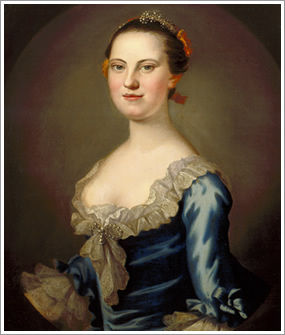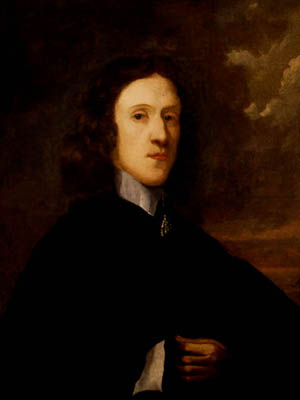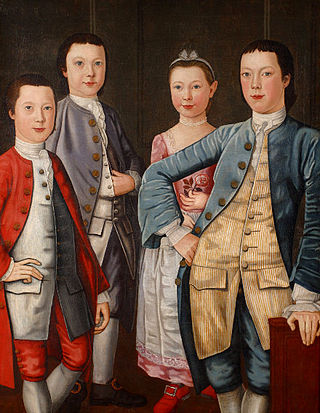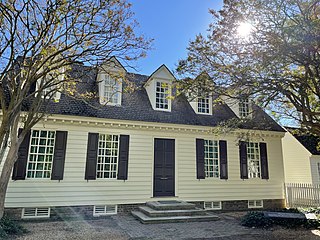
William Byrd II was a North American planter, lawyer, surveyor and writer. Born in the British colony of Virginia, Byrd was educated in London, where he practiced law. Upon his father's death, Byrd returned to Virginia in 1705. He served as a member of the Virginia Governor's Council from 1709 to 1744. Byrd was also the London agent for the House of Burgesses in the 1720s. His life showed aspects of both the British colonial gentry and an emerging American identity.

Westover Plantation is a historic colonial tidewater plantation located on the north bank of the James River in Charles City County, Virginia. Established in c. 1730–1750, it is the homestead of the Byrd family of Virginia. State Route 5, a scenic byway, runs east–west to the north of the plantation, connecting the independent cities of Richmond and Williamsburg.

Mary Willing Byrd was an American planter.

First Families of Virginia (FFV) are the families in colonial Virginia who are socially prominent and wealthy, but not necessarily the earliest settlers. They descend from English colonists who primarily settled at Jamestown, Williamsburg, the Northern Neck and along the James River and other navigable waters in Virginia during the 17th century. These elite families generally married within their social class for many generations and, as a result, most surnames of First Families date to the colonial period.
Henrietta de Beaulieu Dering Johnston was a pastelist of uncertain origin active in the English colonies in North America from approximately 1708 until her death. She is both the earliest recorded female artist and the first known pastelist working in the English colonies, and is the first portraitist known to have worked in what would become the southern United States.

William Randolph I was an English-born planter, merchant and politician in colonial Virginia who played an important role in the development of the colony. Born in Moreton Morrell, Warwickshire, Randolph moved to the colony of Virginia sometime between 1669 and 1673, and married Mary Isham a few years later. His descendants include many prominent individuals including Thomas Jefferson, John Marshall, Paschal Beverly Randolph, Robert E. Lee, Peyton Randolph, Edmund Randolph, John Randolph of Roanoke, George W. Randolph, and Edmund Ruffin. Due to his and Mary's many progeny and marital alliances, they have been referred to as "the Adam and Eve of Virginia".
Thomas Everard (1719–1781) served as mayor of Williamsburg, Virginia from 1766 to 1767. He was a clerk at the House of Burgesses and lived in the Brush-Everard House in Colonial Williamsburg. He supported the fight for independence from the British Empire, including serving on the committee that selected delegates from Virginia for the Continental Congress.

Colonel John Page was a planter, slave trader, merchant and politician in colonial Virginia. Born in East Bedfont, Middlesex, Page eventually migrated to the colony of Virginia, where he lived in Middle Plantation and served as a member of the House of Burgesses from 1665 to 1677 and a member of the Virginia Governor's Council from 1677 to 1692. A wealthy landowner, Page donated land and funds towards construction of the Bruton Parish Church. Page was also involved in the establishment of the College of William & Mary in 1693, as well as being a chief proponent of Middle Plantation being designated the colony's capital in 1698.

Theodorick Bland made a survey in 1693 of the Howson Patent, which is an area corresponding to present day Alexandria, Virginia. He also made a survey for Williamsburg, Virginia in 1699.
William Stith was an early American historian and an Anglican minister. He was the third president of the College of William & Mary (1752–1755), where Stith Hall was named for him.
Sir John Randolph was an American politician. He was a Speaker of the House of Burgesses, an Attorney General for the Colony of Virginia, and the youngest son of William Randolph and Mary Isham.

Clementina Rind was a Colonial American woman who is known as being the first female newspaper printer and publisher in Virginia. Living and working in Williamsburg, Virginia, she took the printing press established by her husband, William Rind, after his death in 1773. Clementina continued to print The Virginia Gazette and also published Thomas Jefferson's tract A Summary View of the Rights of British America.
Charles Bridges was an English painter and missionary active in Virginia from 1735 to 1744. He is the first documented painter known to have worked in Virginia.

John Durand was a colonial American portraitist. With John Mare, Abraham Delanoy, and Lawrence Kilburn, he was one of a number of portraitists living and working in New York City during the 1760s.

William Prentis was born in England and became the leading merchant of early 18th century Williamsburg, Virginia. He was also the father of John Prentis, who served as mayor of Williamsburg from 1759 to 1760; and Joseph Prentis, who represented Williamsburg in the Virginia House of Delegates, serving as that body's Speaker from 1786 until 1788.

The President's House is the residence of the President of the College of William and Mary in Virginia in Williamsburg, Virginia. Constructed in 1732, the building still serves its original purpose and is among the oldest buildings in Virginia. Since its construction only one of the college's presidents, Robert Saunders Jr., has not moved into the building, which is let for free to the president. The President's House is William & Mary's third-oldest building and the oldest official college presidential residence in the United States.

Maria Taylor Byrd was a prominent colonial woman who managed her and her husband William Byrd II's Westover Plantation during his periods of absence. During their lifetimes, William Byrd III and Maria Taylor Byrd's holdings increased to 179,423 acres of land and hundreds of enslaved people. After he died, she was to manage the estate only until her son William Byrd III came of age, but he had married and decided to live with his wife at the family's Belvidere plantation instead. Byrd then continued to manage Westover through her son's first marriage and until her death. She oversaw the plantation's activities, its workers, household duties, and the care and upkeep of the property on the plantation.

The Brush-Everard House, also known as the Everard House and Thomas Everard House, was built by John Bush ca. 1718. One of the oldest houses in Virginia and in Williamsburg, it is located on the east side of Palace Green and next to the Governor's Palace. It is a "five-bay, timber framed, story-and-a-half house of hand-split weatherboard".
Elizabeth Bray Allen also known as Elizabeth Bray Allen Smith Stith operated a large plantation after the death of her first husband, Arthur Allen. After the death of her second husband, she operated both the Allen and Smith estates. She provided the direction and funds to establish a free school for poor boys and girls in Smithfield, Virginia.













